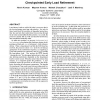Free Online Productivity Tools
i2Speak
i2Symbol
i2OCR
iTex2Img
iWeb2Print
iWeb2Shot
i2Type
iPdf2Split
iPdf2Merge
i2Bopomofo
i2Arabic
i2Style
i2Image
i2PDF
iLatex2Rtf
Sci2ools
HPCA
2005
IEEE
2005
IEEE
Checkpointed Early Load Retirement
Long-latency loads are critical in today's processors due to the ever-increasing speed gap with memory. Not only do these loads block the execution of dependent instructions, they also prevent other instructions from moving through the in-order reorder buffer (ROB) and retire. As a result, the processor quickly fills up with uncommitted instructions, and computation ultimately stalls. To attack this problem, we propose checkpointed early load retirement, a mechanism that combines register checkpointing and back-end--i.e., at retirement--load-value prediction. When a long-latency load hits the ROB head unresolved, the processor enters Clear mode by (1) taking a Checkpoint of the architectural registers, (2) supplying a Load-value prediction to consumers, and (3) EARly-retiring the long-latency load. This unclogs the ROB, thereby "clearing the way" for subsequent instructions to retire, and also allowing instructions dependent on the long-latency load to execute sooner. W...
Computer Architecture | Dependent Instructions | Early Load Retirement | HPCA 2005 | Subsequent Instructions |
| Added | 01 Dec 2009 |
| Updated | 01 Dec 2009 |
| Type | Conference |
| Year | 2005 |
| Where | HPCA |
| Authors | Nevin Kirman, Meyrem Kirman, Mainak Chaudhuri, José F. Martínez |
Comments (0)

